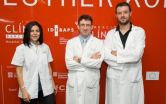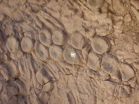(Press-News.org) An international team of researchers has discovered the first DNA faults linked to melanoma - the deadliest skin cancer - that are not related to hair, skin or eye colour.
Cancer Research UK scientists at the University of Leeds, together with a team from the GenoMEL consortium*, scanned the genes in blood samples from almost 3000 Europeans with melanoma, and compared these with samples taken from the general population.
Their findings are published in Nature Genetics today.**
Known risk factors for melanoma include fair skin, blue or green eyes, blond or red hair, a high number of moles, people who burn easily and those who have a family history.
Previous research by these and other scientists identified five pigmentation genes and three 'mole formation' genes, linked to melanoma risk. But the scientists have now discovered three new risk genes ¬– ¬not associated with pigmentation or moles***.
Four per cent of the UK population****, around 2.3m people, will carry two copies of all three gene faults (one copy inherited from each parent). The average risk of developing melanoma is about one in 60. This goes up to one in 46 if a person has both copies of all three gene faults.
Lead author, Professor Tim Bishop, based in the Cancer Research UK centre at the University of Leeds, said: "We know that overexposure to UV increases the risk of developing melanoma – but this evidence shows that there are new additional genetic faults which can push up the risk further.
"It is fascinating to discover these new melanoma risk factors – and we expect that the results of similar studies underway will reveal even more."
Dr Lesley Walker, Cancer Research UK's director of cancer information, said: "These intriguing results provide deeper understanding of the causes of melanoma and provide a potential new approach to identify people most at risk of developing melanoma and other cancers."
One DNA fault was found in the region of a gene called MX2 linked to narcolepsy – a disease thought to be triggered by the immune system which causes people to fall asleep spontaneously.
Another fault was found in a gene called ATM involved in DNA repair – preventing cancer-causing mistakes being passed onto daughter cells.
The third gene fault was found in the CASP8 gene, which plays a role in controlling cell spread by triggering automatic cell death.
There are around 11,770 new cases of malignant melanoma diagnosed each year in the UK and these are mainly caused by overexposure to UV light. Almost one third of all cases of malignant melanoma occur in people under 55. Over the last twenty-five years, rates of malignant melanoma in Britain have risen faster than any of the most common cancers.
Dr Lesley Walker added: "Cancer Research UK has invested heavily in research to identify tiny DNA changes to paint an overall picture of which regions of DNA could be linked to cancer – and we hope that research like this will reveal further genetic secrets to help us diagnose and treat the disease.
"The best way to reduce the risk of skin cancer, is to protect yourself from strong sun by covering up with clothing, spending some time in the shade, and applying at least SPF 15 sunscreen with four or more stars generously and regularly."
INFORMATION:
For more information:
Contact: Paula Gould, University of Leeds Communications & Press Office: Tel +44 (0) 113 343 8059, email p.a.gould@leeds.ac.uk
Notes to editors:
*GenoMEL consortium brings together teams from around the world who are working on the genetics of melanoma and identifying who is prone to developing melanoma. www.genomel.org
**Genome-wide association study identifies three new melanoma susceptibility loci. Nature Genetics. Barrett et al. [doi:10.1038/10.1038/ng.959].
***The new discoveries brings the total to 11 known genetic variations linked to increased melanoma risk and could potentially help identify people at greater risk of developing the disease in the future.
****The estimated resident population in the UK was 62,262,000 in mid-2010 according to figures from the Office for National Statistics of whom 91 per cent have white skin; melanoma is very rare in persons with other than white skin.
About the Leeds Cancer Research UK Centre
The Leeds Cancer Research UK Centre represents a formal partnership between the University of Leeds, Leeds Teaching Hospitals NHS Trust and Cancer Research UK which aims to harness the scientific power of Leeds-based cancer researchers in order to deliver improvements in cancer therapy at local, national and international level.
About the University of Leeds
One of the UK's largest medical, health and bioscience research bases, the University of Leeds delivers world leading research in medical engineering, cancer, cardiovascular studies, epidemiology, molecular genetics, musculoskeletal medicine, dentistry, psychology and applied health. Treatments and initiatives developed in Leeds are transforming the lives of people worldwide with conditions such as diabetes, HIV, tuberculosis and malaria. www.leeds.ac.uk
About Cancer Research UK
Cancer Research UK is the world's leading cancer charity dedicated to saving lives through research
The charity's groundbreaking work into the prevention, diagnosis and treatment of cancer has helped save millions of lives. This work is funded entirely by the public.
Cancer Research UK has been at the heart of the progress that has already seen survival rates double in the last forty years.
Cancer Research UK supports research into all aspects of cancer through the work of over 4,000 scientists, doctors and nurses.
Together with its partners and supporters, Cancer Research UK's vision is to beat cancer.
For further information about Cancer Research UK's work or to find out how to support the charity, please call +44 (0)20 7121 6699 or visit www.cancerresearchuk.org
END
The world's thinnest, strongest and most conductive material, discovered in 2004 at the University of Manchester by Professor Andre Geim and Professor Kostya Novoselov, has the potential to revolutionize material science.
Demonstrating the remarkable properties of graphene won the two scientists the Nobel Prize for Physics last year and Chancellor of the Exchequer George Osborne has just announced plans for a £50m graphene research hub to be set up.
Now, writing in the journal Nature Physics, the University of Manchester team have for the first time demonstrated how graphene ...
The genomic analysis technologies enable the study of genetic factors related to numerous diseases. In few areas this researches brought such a big and useful volume of information as in the case of melanoma. A study published in Nature Genetics, promoted by the GenoMEL consortium, consolidates the results obtained in previous whole-genome analysis and identifies three new chromosomal regions implicated in susceptibility to melanoma. The GenoMEL consortium is funded by the European Commission and the National Institutes of Health (USA) to increase the understanding of genetic ...
MADISON – An ongoing lack of sleep during adolescence could lead to more than dragging, foggy teens, a University of Wisconsin-Madison study suggests.
Researchers have found that short-term sleep restriction in adolescent mice prevented the balanced growth and depletion of brain synapses, connections between nerve cells where communication occurs.
"One possible implication of our study is that if you lose too much sleep during adolescence, especially chronically, there may be lasting consequences in terms of the wiring of the brain," says Dr. Chiara Cirelli, associate ...
New York University biologists have identified a new mechanism for regulating color vision by studying a mutant fly named after Frank ('Ol Blue Eyes) Sinatra. Their findings, which appear in the journal Nature, focus on how the visual system functions in order to preserve the fidelity of color discrimination throughout the life of an organism. They also offer new insights into how genes controlling color detection are turned on and off.
Many biologists study how different cells develop to acquire their fate. The NYU research team, headed by Claude Desplan, a professor ...
All cells in our body have a system that can handle cellular waste and release building blocks for recycling. The underlying mechanism is called autophagy and literally means "self-eating". Many cancer cells have increased the activity of this system and the increased release of building blocks equip the cancer cells with a growth advantage and can render them resistant towards treatment.
"We have discovered a small molecule that can block autophagy in different cancer cells and specifically, this molecule can increase the sensitivity of breast cancer cells towards one ...
24-7PressRelease.com announces today that it has reached a milestone, having distributed 175,000 press releases to date.
"The news is exciting for the company," said Michael Iwasaki, Managing Partner with 24-7PressRelease. "We continue to expand and grow in popularity with marketing, PR and communications companies looking for excellent value combined with excellent customer service. The economy is still in extreme turmoil. We are continually receiving positive feedback."
The company also offers website owners the option to add their top news ...
A new study has found that an osteoporosis drug protects against the bone damaging side effects of certain breast cancer medications. Published early online in Cancer, a peer-reviewed journal of the American Cancer Society, the study indicates that some breast cancer patients could take zoledronic acid in addition to their anti-cancer medications to maintain bone health.
Drugs called aromatase inhibitors stop the production of estrogen in postmenopausal women and therefore make less estrogen available to stimulate the growth of certain breast cancer cells. Many postmenopausal ...
KINGSTON, R.I. -- October 10, 2011 -- While the cause of the mass extinction that occurred between the Permian and Triassic periods is still uncertain, two University of Rhode Island researchers collected data that show that terrestrial biodiversity recovered much faster than previously thought, potentially contradicting several theories for the cause of the extinction.
David Fastovsky, URI professor of geosciences, and graduate student David Tarailo found that terrestrial biodiversity recovered in about 5 million years, compared to the 15- to 30-million year recovery ...
VIH. Ross Ford, president and CEO of TCN Worldwide, is pleased to announce The Bradco Companies as the newest member to join the international real estate services organization. The Bradco Companies/TCN Worldwide is a full-service real estate firm specializing in the acquisition and disposition of raw land, commercial and industrial land projects for developers and investors as well as in the leasing and sales of commercial, industrial and office properties throughout Southern California's High Desert Regions, including Palmdale; Lancaster; Adelanto; Hesperia; Barstow; ...
Boulder, CO, USA - Long before whales, the oceans of Earth were roamed by a very different kind of air-breathing leviathan. Snaggle-toothed ichthyosaurs larger than school buses swam at the top of the Triassic Period ocean food chain, or so it seemed before Mount Holyoke College paleontologist Mark McMenamin took a look at some of their remains in Nevada. Now he thinks there was an even larger and more cunning sea monster that preyed on ichthyosaurs: a kraken of such mythological proportions it would have sent Captain Nemo running for dry land. McMenamin will be presenting ...


